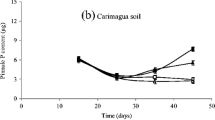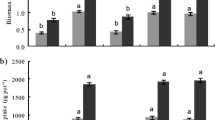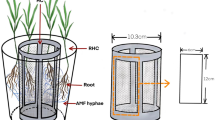Abstract
Fungi are usually thought not to have a boron (B) requirement. It is not known if mycorrhizas take up B from low concentrations that are common in forest soils, as fungi might also immobilise B. Here, we studied the B concentrations in sporophores of 49 ectomycorrhizal and 10 saprotrophic fungi to assess whether B is translocated in mycelium or not. Additionally, P and metal concentrations were measured for comparison. Variability both within species and between species was very large, as the lowest measured B concentration was 0.01 mg kg−1 in Amanita muscaria, and the highest was 280 mg kg−1 in Paxillus involutus. There was no clear difference between saprotrophic and mycorrhizal fungi. The majority of species did not accumulate B at more than 0.01–3 mg kg−1, but there were some species that consistently had median concentration values higher than 5–6 mg kg−1 and much higher maximum values, particularly Paxillus involutus, Lactarius necator and several Russula species. Most species increased their B concentration in B fertilised plots, but there were exceptions, particularly Rozites caperatus and Lactarius camphoratus. Boron concentrations did not correlate with those of other elements. In conclusion, B is translocated in the mycelia of most of the studied species. The differences between species may be due to differences in their water use, or carbohydrates used in translocation. It remains to be studied, if B concentrations in mycorrhizas or mycelia in soil are in the same order of magnitude as the larger ones found here, and if this has any effects on the host plants.


Similar content being viewed by others
References
Aphalo PJ, Schoettle AW, Lehto T (2002) Leaf life span and the mobility of non-mobile” mineral nutrients—the case of boron in conifers. Silva Fenn 36:671–680
Berthelsen BO, Olsen RA, Steinnes E (1995) Ectomycorrhizal heavy metal accumulation as a contributing factor to heavy metal levels in organic surface soils. Sci Total Environ 170:141–149
Brown PH, Shelp BJ (1997) Boron mobility in plants. Plant Soil 193:85–101
Cajander AK (1949) Forest types and their significance. Acta For Fenn 56:1–71
Chudzynski K, Falandysz J (2008) Multivariate analysis of elements content of Larch Bolete (Suillus grevillei) mushroom. Chemosphere 73:1230–1239
Dannel F, Pfeffer H, Römheld V (2002) Update on boron in higher plants–uptake, primary translocation and compartmentation. Plant Biol 4:193–204
Dordas C, Brown PH (2001) Evidence for channel mediated transport of boric acid in squash (Cucurbita pepo). Plant Soil 235:95–103
Fitzpatrick KL, Reid RJ (2009) The involvement of aquaglyceroporins in transport of boron in barley roots. Plant Cell Environ 32:1357–1365
Goldbach HE, Wimmer MA (2007) Boron in plants and animals: Is there a role beyond cell-wall structure? J Plant Nutr Soil Sci 170:39–48
Halonen O, Tulkki H, Derome J (1983) Nutrient analysis methods. Finnish For Res Inst Res Notes 121:1–28
Hansen I, Knudsen H (1992) Nordic Macromycetes Vol 2, Polyporales, Boletales, Agaricales, Russulales. Nordsvamp, Helsinki. 474pp
Hedh J, Johansson T, Tunlid A (2009) Variation in host specificity and gene content in strains from genetically isolated lineages of the ectomycorrhizal fungus Paxillus involutus s. lat. Mycorrhiza 19:549–558
Högberg MN, Högberg P (2002) Extramatrical ectomycorrhizal mycelium contributes one third of microbial biomass and produces, together with associated roots, half the dissolved organic carbon in a forest soil. New Phytol 154:791–795
Hu H, Brown PH (1997) Absorption of boron by plant roots. Plant Soil 193:49–58
Hu H, Penn SG, Lebrilla CB, Brown PH (1997) Isolation and characterization of soluble boron complexes in higher plants. The mechanism of phloem mobility of boron. Plant Physiol 113:649–655
Kaya A, Karakaya HC, Fomenko DE, Gladyshev VN, Koc A (2009) Identification of a novel system for B transport: Atr1 is a main boron exporter in yeast. Molecular and Cellular Biology: 3665–3674
Lehto T (1995) Boron retention in limed forest mor. Forest Ecol Manage 78:11–20
Lehto T, Mälkönen E (1994) Effects of liming and boron fertilization on boron uptake of Picea abies. Plant Soil 163:55–64
Lehto T, Lavola A, Kallio E, Aphalo PJ (2004a) Boron uptake by ectomycorrhizas of silver birch. Mycorrhiza 14:209–212
Lehto T, Lavola A, Julkunen-Tiitto R, Aphalo PJ (2004b) Boron retranslocation in Scots pine and Norway spruce. Tree Physiol 24:1011–1017
Lehto T, Räisänen M, Lavola A, Julkunen-Tiitto APJ (2004c) Boron mobility in deciduous forest trees in relation to their polyols. New Phytol 163:333–339
Lewis DH (1980) Boron, lignification and the origin of vascular plants—a unified hypothesis. New Phytol 84:209–229
Lilleskov EA, Bruns TD, Dawson TE, Camacho FJ (2009) Water sources and controls on water-loss rates of epigeous ectomycorrhizal fungal sporophores during summer drought. New Phytol 182:483–494
Marschner H (1995) Mineral nutrition of higher plants. Academic Press
Martin F, Nehls U (2009) Harnessing ectomycorrhizal genomics for ecological insights. 12: 508–515
Michael G, Marschner H (1962) Einfluss unterschiedlicher Luftfeuchtigkeit und Transpiration auf Mineralstoffaufnahme und–Verteilung Z Pflanzenernähr Düng Bodenk 96: 200–212
Möttönen M, Lehto T, Aphalo PJ, Kukkola M, Mälkönen E (2003) Response of mature stands of Norway spruce (Picea abies) to boron fertilization. For Ecol Manage 180:401–412
Möttönen M, Lehto T, Rita H, Aphalo PJ (2005) Recovery of Norway spruce (Picea abies) seedlings from repeated drought as affected by boron nutrition. Trees 19:213–223
Nehls U (2008) Mastering ectomycorrhizal symbiosis: the impact of carbohydrates. J Exp Bot 59:1097–1108
Ohtonen R (1982) Mineral concentrations in some edible fungi and their relation to fruit-body size and mineral status of substrate. Ann Bot Fennici 19:203–209
Räisänen M, Repo T, Lehto T (2009) Cold acclimation of Norway spruce roots and shoots after boron fertilization. Silva Fenn 43:223–233
Shi L, Guttenberger M, Kottke I, Hampp R (2002) The effect of drought on mycorrhizas of beech (Fagus sylvatica L): changes in community structure, and the content of carbohydrates and nitrogen storage bodies of the fungi. Mycorrhiza 12:303–311
Smith SE, Read DJ (2008) Mycorrhizal symbiosis. Academic Press
Sutinen S, Vuorinen M, Rikala R (2006) Developmental disorders in buds and needles of mature Norway spruce, Picea abies (L.) Karst, in relation to needle boron concentrations. Trees 20:559–570
Tanaka M, Fujiwara T (2008) Physiological roles and transport mechanisms of boron: perspectives from plants. Eur J Physiol 456:671–677
Tibbett M, Sanders FE, Cairney JWG (2002) Low-temperature-induced changes in trehalose, mannitol and arabitol associated with enhanced tolerance to freezing in ectomycorrhizal basidiomycetes (Hebeloma spp.). Mycorrhiza 12:249–255
Tyler G (1980) Metals in sporophores of Basidiomycetes. Trans Brit Mycol Soc 74:41–49
Tyler G (2005) Changes in the concentrations of major, minor and rare-earth elements during leaf senescence and decomposition in a Fagus sylvatica forest. Forest Ecol Manage 206:167–177
Wallander H, Nilsson LO, Hagerberg D, Bååth E (2001) Estimation of the biomass and seasonal growth of external mycelium of ectomycorrhizal fungi in the field. New Phytol 151:753–760
Acknowledgements
We thank Germund Tyler for kindly informing us about the data on B concentrations in sporophores that were inadvertently left out from his paper (Tyler 2005). We thank Aino Rummukainen and Mikko Räisänen for help in the field, and Merja Essell and Rauni Oksman in the laboratory. The study was supported by the Foundation for Research of Natural Resources in Finland, and at the reporting stage, the Academy of Finland, decision n:o 123637.
Author information
Authors and Affiliations
Corresponding author
Rights and permissions
About this article
Cite this article
Lavola, A., Aphalo, P.J. & Lehto, T. Boron and other elements in sporophores of ectomycorrhizal and saprotrophic fungi. Mycorrhiza 21, 155–165 (2011). https://doi.org/10.1007/s00572-010-0321-7
Received:
Accepted:
Published:
Issue Date:
DOI: https://doi.org/10.1007/s00572-010-0321-7




